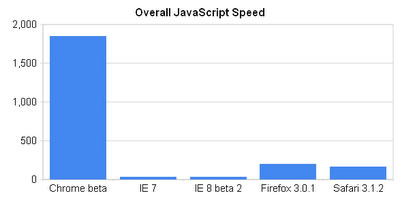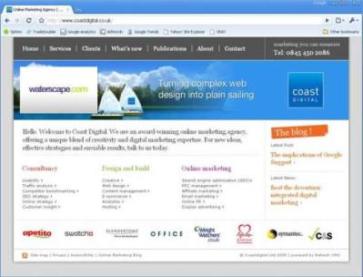Google unveiled Chrome, the company’s first desktop web browser on Tuesday, following the news that a printed comic book revealing details about the previously unconfirmed browser had landed in the hands of a blogger – who duly uploaded the material onto the internet.
 Delaying the release of the link to download the software (it later emerged that it would be available at 12 noon, Californian time) on Tuesday only made the blogosphere buzz with speculation and hype about the forthcoming ‘new kid’ on the block.
Delaying the release of the link to download the software (it later emerged that it would be available at 12 noon, Californian time) on Tuesday only made the blogosphere buzz with speculation and hype about the forthcoming ‘new kid’ on the block.
Google claim that Chrome is “many times faster” than its rivals at running JavaScript – the underlying language which runs much of the internet’s rich web 2.0 content – Google’s Docs, Gmail and Reader included.
The search giant, in a bold move, has rewritten the “virtual machine” that runs much of the web application code ‘from the bottom up’ with a view to greatly increasing operating speeds. Reportedly, the team did so in only four months, and aimed to increase operating speed by a factor of 10.
These claims have already been tested and verified by a member of the ZDNet network, testing the new browser against Internet Explorer, IE 8 beta 2, Firefox 3.0.1 and Safari 3.1.2. (Image/chart credits to Stephen Shankland/CNET News)

The comic book related press release revealed a number of features and details of the browser, some of which have already caused some controversy and excitement amongst web users across the globe:
- Chrome is open source and built from scratch.
- The team have built a new JavaScript Virtual Machine called V8 ‘from the ground up’ – this is said to be dramatically faster than previous Java VM’s.
- Each ‘tab’ in the browser runs in isolation in the background, so that bugs and crashes are isolated to the tab, not the whole browser.
- An advanced URL bar called “OmniBox”, combines the traditional URL bar and similar technology used in Google’s recently released Suggest feature.
- Tabs feature at the top of the window, rather than in the more familiar position below the address bar.
- A mode aptly named ‘Incognito’ designed to prevent user details, history and cookies from being stored on the PC.
- The browser makes use of the WebKit Open Source rendering engine, the same engine which Apple’s own browser, Safari is based on.
- Plug-ins are removed from the rendering process and are run separately.
One of the major developments in the browser is the implementation of MultiProcess architecture, the system that allows the computer to keep going when an application crashes or freezes.
Google have ported this concept to the browser, so that if something goes wrong in a tab, the whole browser doesn’t come crashing down around it. This is especially significant as more and more applications which were traditionally desktop-based make the switch to the browser environment.
Chrome also allows tabs to be dragged in and out of separate instances of the browser, so you can create a new window from a tab.

The project began with a small prototype emerging internally at Google in June 2006, where the decision was made to use the WebKit rendering engine, which powers Apple’s Safari browser.
The decision to use this over Gecko, used by Firefox, was due to operating speed – it was rumoured to be over three times faster in some cases, and had already been used by the Android team, working on Google’s answer to the Smartphone interface.
When testing the browser, Google used a secret weapon – the data collected from the search engine they’re so well known for.
‘ChromeBot’ torture tested the browser by loading one million web pages which users are likely to view in the browser. This rapidly highlighted the importance of the various bugs in the system and allowed the development team to prioritise them based on real world data.
Chrome may signify Google’s first foray into the browser market, but it certainly won’t be the last time they release a web browser – the upcoming open source mobile platform, Android, will feature integrated browser functionality, one of the key building blocks for the ongoing mobile web revolution.
Questioning Google’s motives behind the release is one of the hot discussion topics on the web at the moment, and no doubt will continue to be for some time.
However, it would be fair to suggest that if more people successfully use and enjoy the web, that’s good news for Google – they generate revenue from search based ad targeting – so they continue to increase their potential audience.
A number of Google’s major non-search offerings, Mail, Reader and Apps, for example, rely heavily on the JavaScript engine, introducing another clear incentive to improve the operating environment – as a knock-on effect, improving usability as V8 improves stability and speeds these apps up for users. It seems that focus is around two key elements, paramount to the Google ethos; to look cleaner and to run faster.
Perhaps most significant to the end user, including people who aren’t likely to download the Chrome beta at this early stage, is the decision by Google to make the project open source. They claim to be encouraging other browser development teams to use the V8 JavaScript environment to improve their browsers. By doing so, Google have raised the bar for their competitors, while also offering them a leg up.
For those of you keen to see the market share of the browser on your own websites, hold on for a little while – as Google Chrome isn’t launched to the general public until the beginning of September. Google hadn’t, at the time of writing, changed Analytics to recognize Chrome when segmented by browser within reports. They have promised that this will change in the coming weeks (until then, the browser will show as Firefox).
Google think that once developers get the taste for this potential application speed over the web, they will start producing amazing, more creative web applications which would have previously been hindered by browser limitations. From this point of view, it appears that the browser war is about to become a very significant game of catch-up.
